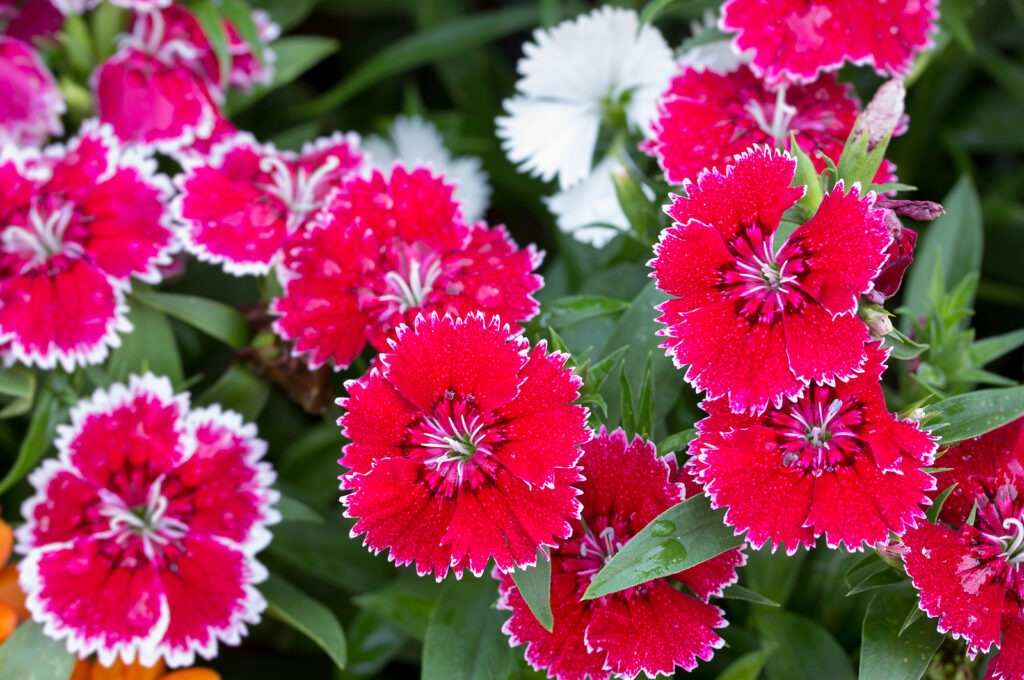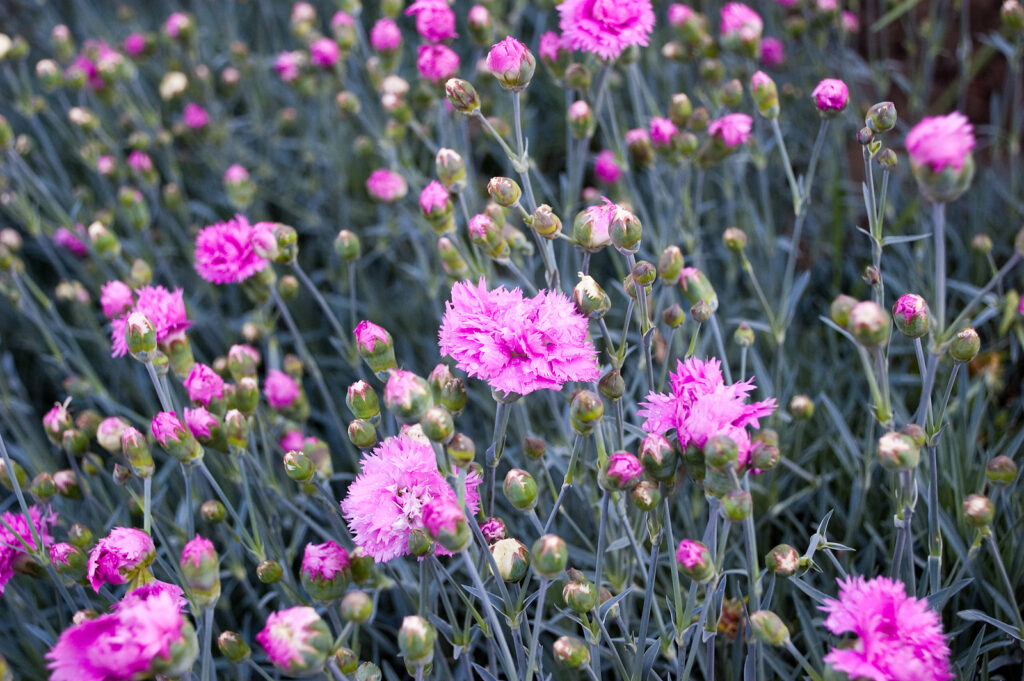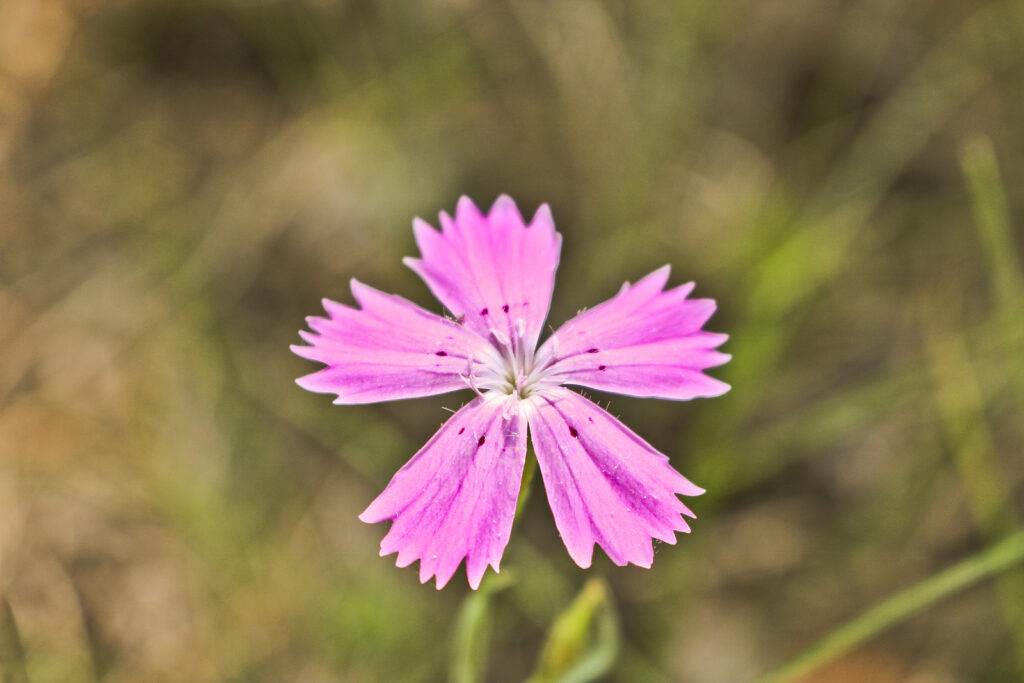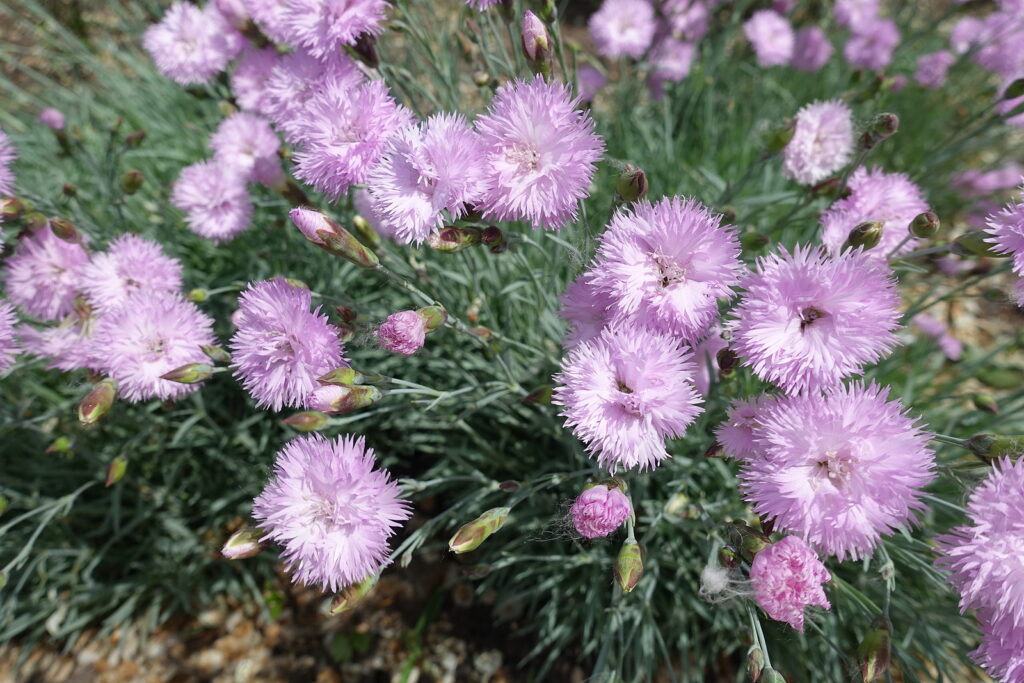Dianthus–commonly called garden pinks–are bushy upright plants with lance-shaped leaves and domed heads of sweet-scented flowers that bloom pink, red, burgundy, white, or bicolored in summer. Garden pinks are a mainstay of cottage garden beds.
The term “pinks” is an archaic common name for the Dianthus species. There are many dianthus species. Three commonly grown in gardens are:
- Dianthus barbatus is known as Sweet William. These are spring-blooming biennials that grow 12 to 24 inches (30-61cm) tall. Flowers form densely packed, sweetly scented flat clusters up to 5 inches (12.5cm) across.
- Dianthus caryophyllus is known as carnation, border carnation, florist’s carnation, and pink. Carnations are best known as cut flowers. They are short-lived perennials. These grow to 2 feet (61cm) tall.
- Dianthus chinensis is known as pink or China pink. There are a number of cultivars that grow 6 to 8 inches (15-20cm) tall. The petals are serrated.

Dianthus plumarius (garden pinks), Dianthus chinensis (China pinks), and Dianthus barbatus (sweet William). They come in shades of pink, red, white, and bi-color, often with contrasting “pinked” (jagged) petal edges, which is where the name “pinks” originates.
Dianthus is typically grown as a perennial or biennial, depending on the variety and climate. These plants are low-growing, typically reaching heights of 6–18 inches, with some taller varieties. They’re perfect for adding charm and elegance to garden spaces while providing delightful fragrance.
Seven Ways to Use Dianthus in the Garden
- Borders and Edging
- Dianthus is ideal for the front of borders due to its low, compact growth habit.
- Use it to edge paths, walkways, or garden beds to create a neat and colorful border.
- Rock Gardens
- Pinks thrive in well-drained, sandy soils, making them excellent candidates for rock gardens.
- Their cushion-like growth habit pairs beautifully with rocks and gravel.
- Containers and Window Boxes
- Dianthus performs well in containers and window boxes, where its delicate blooms can be appreciated up close.
- Pair it with other sun-loving plants, such as petunias or trailing lobelia, for a stunning container display.
- Cottage Gardens
- Pinks are classic cottage garden plants, often used in informal, romantic designs.
- Combine them with plants like roses, foxgloves, or lavender for a timeless look.
- Wildlife and Pollinator Gardens
- Dianthus attracts pollinators like bees and butterflies, making it a valuable addition to wildlife-friendly gardens.
- Plant it near nectar-rich flowers to enhance its pollinator appeal.
- Cutting Gardens
- Many dianthus varieties, especially taller ones like sweet William, make excellent cut flowers.
- Use them in bouquets for their fragrance and long-lasting blooms.
- Herb or Scented Gardens
- With its spicy fragrance, dianthus is perfect for sensory or herb gardens.
- Plant it near seating areas or pathways where its scent can be enjoyed.
Design Ideas with Dianthus
- Color Themes
- Use white and pale pink varieties to create a soft, romantic garden palette.
- Add deeper reds or magentas for striking contrasts in mixed plantings.
- Pairing with Silver Foliage
- Dianthus pairs beautifully with silver-leaved plants like lamb’s ear or artemisia. The foliage highlights the vivid colors of the flowers.
- Formal Designs
- In formal gardens, use dianthus to create geometric patterns or knots. Its neat growth habit works well for symmetrical planting schemes.
- Low-Maintenance Ground Cover
- Use spreading varieties of dianthus to fill gaps in sunny flower beds or cover bare patches of soil.
- Cascading Effect
- Plant trailing varieties in raised beds, containers, or rock walls to create a cascading effect of blooms.
Quick Care Tips for Dianthus
- Light: Thrives in full sun but tolerates partial shade in hotter climates.
- Soil: Prefers well-drained, slightly alkaline soil with moderate fertility.
- Watering: Water regularly but avoid waterlogging. Dianthus prefers slightly dry conditions once established.
- Deadheading: Remove spent flowers to encourage reblooming.
- Fertilizing: Use a balanced, slow-release fertilizer at planting or early in the season.
- Pruning: Cut back plants after the first flush of blooms to promote new growth and additional flowers.
- Pests and Diseases: Dianthus is generally trouble-free but may occasionally encounter slugs or fungal issues. Ensure good air circulation and avoid wetting the foliage.
Deanthus Seasonal Notes
- Dianthus is perfect for spring and summer gardens. In mild climates, some varieties may bloom sporadically into fall.
- Mulch lightly in winter to protect plants from frost in colder regions.
Dianthus is a classic, low-maintenance plant that brings charm, fragrance, and vibrant color to garden spaces. Do you plan to incorporate it into a formal design, cottage garden, or another creative setting?
Get to know garden Dianthus — pinks
- Plant type: Cool-season annual, biennial, or perennial depending on the species
- Growing Zones and range: 2-11
- Hardiness: Hardy to -30°F (-34°C); most do best in cool climates; there are species for all climates
- Height and width: 4 to 24 inches (10-61cm) tall; 6 to 30 inches (15-76cm) wide
- Foliage: Leaves and linear to lance-shaped, mostly pointed, and often blue-gray and gray-green.
- Flowers: Flat, ruffled. toothed, fringed, or lacy single or double flowers 1/2 to 2 inches wide; single forms usually have 5 petals. Pinks are distinguished by the serrated edges of their flower petals.
- Flower colors: Shades of red and pink; also white, yellow, and mahogany
- Bloom time: Spring and summer; all year in Zones 10-11
- Uses: Bedding plants, borders, cutting flowers
- Common name: Pinks, Sweet William
- Botanical name: Dianthus spp.
- Family: Caryophyllaceae
- Origin: South, central, and eastern Europe and Northern Asia and Japan

Where to plant Dianthus — pinks
- Grow Dianthus in full sun to light shade in Zones 3-7. Grow pinks in light shade in Zones 7-9.
- Plant Dianthus in average to humus-rich, well-drained, slightly alkaline soil.
- Add aged compost to the planting bed ahead of planting.
- Dianthus prefers a soil pH of 6 to 7.5.
Dianthus uses and companions
- Use Dianthus barbatus mass-planted in formal gardens; scatter them about the cottage garden to allow them to self-sow. This is a long-lasting cut flower.
- Dianthus deltoides is an excellent ground cover in rock gardens, along paths, or between pavers. Plant these in wall crevices or use them as garden edging.
- Dianthus gratianopolitanus can be used in rock gardens nestled against rocks. Plant these in foreground in a formal border or use them to edge a path.
- Dianthus plumarius can be used in rock and cottage gardens; use it as edging in an informal border.
- Good garden companions for Dianthus include Campanula, Convolvulus mauritanicus, Iberis sempervirens, Iris, Lychnis coronaria, Phlox subulata, Stachys lanata.

When to plant Dianthus — pinks
- Sow dianthus indoors 8 to 12 weeks before the last frost in spring. Set plants outdoors once the danger of frost is past, after hardening them off in the shade for a few days.
- Sow perennial species in spring or summer in cool-summer regions; sow in fall or winter in Zones 9 to 11.
- Sow biennials species in fall in Zones 9-11; sow in early to late summer in cool summer regions.
- Plant annual China pinks in late fall or very early spring in Zones 8-11. Plant pinks in early spring in Zones 3-7. Plant perennial pinks in spring.

Planting and spacing Dianthus — pinks
- Sow seeds 1 inch (2.5cm) apart and barely cover them with soil. Keep them at 75°F (24°C) until they germinate; germination takes about 7 days. Then reduce temperatures to 60° to 70°F (15.6-21°C).
- Indoors start seed in a bright window or under a fluorescent light.
- Sow seed outdoors in smoothly prepared soil; plant seeds 2 inches (5cm) or more apart.
- Press seeds into the soil and cover them with 1/8 inch of soil. Do not let the seedbed dry out.
- Space pinks 6 inches (15cm) to 2 feet 61cm) apart depending on the variety. Thinnings can be carefully transplanted to a new location.
How to water and feed Dianthus — pinks
- Water deeply then allow the soil to just dry between watering when growing pinks.
- Fertilize lightly at planting time and then every 4 to 6 weeks with an all-purpose fertilizer; annual dianthus requires more fertilizer than perennial species because of the long bloom time.
- Mulch around plants in dry regions; mulch with aged compost or chopped leaves.

Dianthus — pinks care
- Deadheading flowers will hasten reblooming.
- Pinch back growth tips for bushier plants.
- Tall varieties may need staking to keep from flopping.
- Pinks commonly self-sow.
- Protect perennial species with a light mulch after the ground freezes in winter.
- For larger carnation flowers, remove all but one flower bud per plant.
Dianthus — pinks pests and diseases
- Dianthus can be attacked by cutworms and slugs. Diseases are rarely a problem.
Dianthus — pinks propagation
- Dianthus can be propagated by seed. Seeds germinate in 5 days at 70°F (21°C).
- Chills seeds of Dianthus caryophyllus for 1 to 2 weeks before sowing.
- Do not cover the seeds of D. caryophyllus; lightly cover the seeds of D. chinensis and D. barbatus.
- Seedlings can be transplanted outdoors when temperatures reach 50° to 55°F (10°-13°C).
- Propagate Dianthus by tip or stem cuttings; take a 3-inch (7.6cm) cutting and root in a mixture of half peat moss and half sand. Take cuttings from plants in full growth in summer. Do not let cutting dry out; roots should appear in about 4 weeks.
- Dianthus can be propagated by layering; nick a long stem and cover the nick with moist soil; roots should form in 6 to 8 weeks.
- Divide perennial species in early spring when new growth begins.

Pinks varieties to grow
- Alpine pink (Dianthus alpinus) mound-forming 3 to 6 inches (7.6-15cm) tall; bears single flowers in late spring or early summer.
- Allwood pinks (D. allwoodii) are similar to D. plumaris.
- Deptford pink (D. armeria) rosette-forming 16 inches (40cm) tall bears clusters of small rosy pink flowers in summer.
- Sweet William (D. barbatus) can be grown as an annual or perennial; used in cottage gardens and flower borders; grows 12 to 24 inches (30-61cm) tall; bears showy 3 to 4 inches wide, flat-topped clusters of flowers from late spring into early summer; many hybrids and cultivars widely available.
- Wild carnations (D. caryophyllus) is a tender perennial that bears small clusters of small fragrant flowers; this species is the predecessor of the florist’s carnation; select a cultivar developed for gardens; long-stemmed cut flowers.
- China pink (Dianthus chinensis) is a scented annual; use as bedding and edging; 6- to 12-inch (15-30cm) biennial or perennial with lance-shaped leaves; bears scentless flowers with fringed petals in 3-inch wide clusters from mid-summer to fall; ‘Parfait’ and Carpet Series are popular.
- Maiden pink (D. deltoides) is a perennial that blooms up to 2 months; use a groundcover grows 6 to 12 inches (15-30cm) tall; rose-red flowers from early to midsummer; cold tolerant to -40°F (-40°C).
- Cheddar pink (D. gratianopoitanus) is a fragrant perennial; use as a groundcover and in mixed borders; bears fragrant 1-inch wide flowers in late spring; heat tolerant; cold tolerant to -20°F (-29°C).
- Dianthus hybrids. Thousands of hybrid cultivars are available as the result of countless crosses by hybridizes; heights range from 8 to 18 inches (20-45cm) and plants bloom in spring and summer; favorite cultivars include heat-tolerant ‘Bath’s Pink’, ‘Essex Witch’ with fringed rose-pink petals, ‘Gran’s Favorite’ with white flowers and spicy scent, ‘Little Jock’ with pink fringed petals, ‘Mrs. Sinkins’ with fragrant white flowers, and spicy-scented ‘Pikes Pink’. Other commonly available Dianthus hybrids include popular bedding varieties ‘Telstar’, ‘Telstar Picotee’, and ‘Brilliancy’.
- Cottage pink, border pink (D. plumarius) is a fragrant perennial; use in beds, borders, cottage gardens, and containers; forms 12 to 24-inch (30-61cm) mounds; bears fragrant 1-inch-wide single, semidouble, or double flowers carried two to five per stems from spring to early summer.
Pinks — Dianthus frequently asked questions
Q: Why are these flowers called pinks? I have seen white and red pinks.
A: China pinks can be red, white, pink, or lilac in color. They are called pinks because of their ruffled petal edges that look like they were cut with pinking shears. Pinking shears are scissors with saw-toothed instead of straight blades. They produce a zigzag pattern.
Q: Can you suggest the best China pinks varieties?
A: Pinks (Dianthus chinensis) varieties include China Doll an All-American winner with double flowers and mixed colors. Telstar is heat resistant. Magic Charms and Princess are compact plants that bloom all summer. Snowfire has white bloom with red centers and is heat resistant.
Q: Do pinks grow best in cool weather?
A: All pinks (dianthus) are frost-tolerant and many are nearly perennials able to withstand below-freezing temperatures. Many newer varieties are heat-resistant. Generally, pinks prefer cool to moderate temperatures and high humidity.



